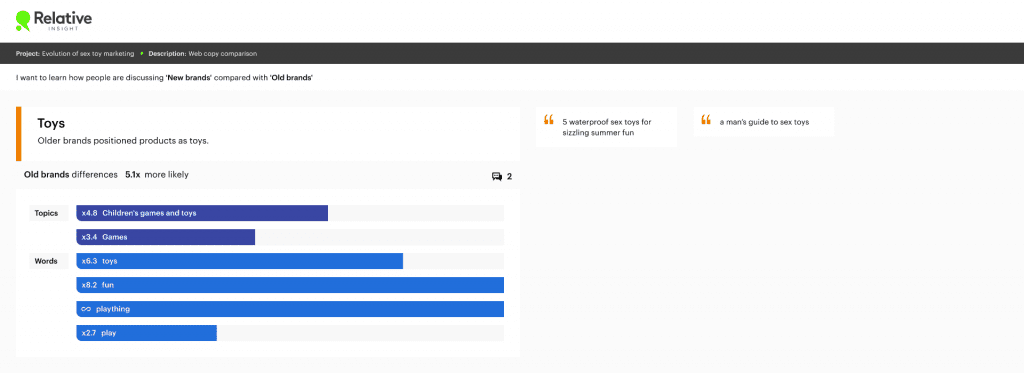How modern sex toy marketing broke the stigma

An industry once relegated to shady specialty shops and discreet packaging, sex toy companies now occupy space on billboards and in mainstream stores like Target.
This path to public acceptance is due in part to a shift in sex toy marketing and messaging efforts from newer brands like Dame, Lelo and Je Joue.
Brands are using Relative Insight to analyze their messaging and tone of voice in comparison to competitors. We wanted to qualify this shift within the sex toy industry and understand the exact messaging that modern brands use in comparison to their old school counterparts.
Relative Insight’s NLP technology compares any two textual data sets to pinpoint the topics, words, phrases, grammar and emotion that are unique to each. This form of comparative text analysis shows us what’s different – between competitors, audiences, locations, over time and more.
For this analysis, we analyzed sex toy marketing materials from nearly 20 brands – including website copy, product descriptions and blog posts. Here’s what we found:
Newer brands
Our analysis found that modern brands are more likely to publish blogs and marketing content focused on sexual education, which we observed through the use of words like education, practice and learning. These brands avoid colloquialisms, opting for correct anatomical language instead.
Part of this educational mission included discussions around consent, as they were 2.6x more likely to use words like consent, partner, boundaries and communication. Online content addressed the intersection of sex and other social movements like gender equality, racial equality and LGBTQ+ issues.


For a long time, the topic of sex was accompanied by stigma – especially for women. All of these modern brands use messaging and words like shame, stigma, and shameless to fight the negative reputation around a woman’s sexual identity. Social acceptance is key in realizing the rapid growth the industry is expecting in the next decade.
The last trend we observed in our analysis of modern sex toy marketing is the use of science. The majority of product descriptions and website copy that we analyzed touted research-backed accolades, which included words like study, research, report and experiment. This form of marketing helps to create trust in the consumer and belief in the brand’s product development process.
Older brands
In comparison, the older more established brands that we analyzed were found to market sex toys as simply that – toys. These brands, including Vibratex and Magic Wand, were 5.1x more likely to use words like plaything, play, and fun in website copy and product descriptions. This lighthearted approach differed from the modern brands, which addressed serious topics like consent and sexual education.


Product descriptors fell into two categories – superlative and seductive. The first category included words like super, incredible and deluxe. The latter utilized words like naughty, sexy, sultry and pleasure. In contrast, newer brands used less of these filler adjectives, in favor of research-backed endorsements.
In line with social standards of the time, older brands used secretive language to talk about products. We found increased use of the words secret, discreet and disguised when compared to modern brands. The stigma associated with sex products may have forced these brands to take this position, as in the past consumers might not purchase a product unless they could ensure discretion. Although public opinion has changed with time, these brands have not adapted or modernized their language.
What does this mean?
Our analysis found distinct differences in the way newer and older sex toy brands approach marketing. Modern companies embrace science, education and acceptance – while established brands continue to use traditional messaging with secretive and seductive language.
This form of competitor benchmarking can equip traditional brands with insights that can help them modernize their language, remain relevant and ultimately appeal to a wider demographic.
